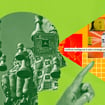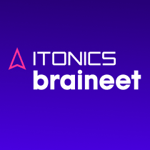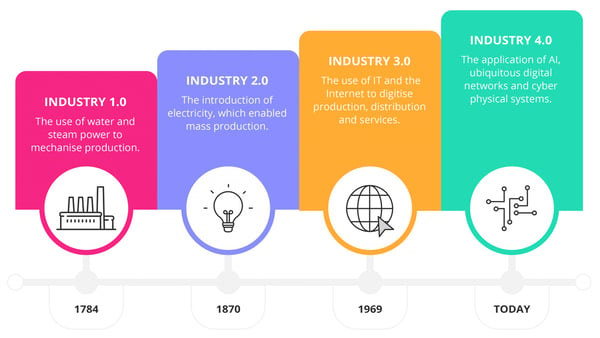An Example Case from the Banking, Finance, and Insurance Sector.
Today we stand on the threshold of the next great revolution. Revolutions are nothing new. Nevertheless, they bring new things and are drivers of change. Industry 4.0 is pushing artificial intelligence (AI) and will significantly shape - perhaps even control - the way we live and work.
Christian Mühlroth, Chief Commercial Officer at ITONICS, deals with these changes on a daily basis. In the following article he uses the example of the finance and insurance sector to illustrate what the AI revolution can mean for the future and how applying this new technology is already revolutionizing innovation management today.
Visible Change
Let's move back in time: One of the most important revolutions, which simultaneously initiated one of the greatest technological changes, was the invention of the steam engine in 1784. Water and steam power were used to mechanize production processes - industrialization in England became unstoppable.
A century later, electricity followed, which increased the pace of production enormously and thus particularly advanced mass production. Since 1969, IT and the Internet have been on the rise, digitizing services, products, and whole business models at an increasing speed. The effects of this development are now more than ever omnipresent - whether in our business world or in the private sphere. The next major revolution is just around the corner.
With extensive digital networks, physical cyber systems, and AI applications we are currently heralding the next revolution. The investment manager BlackRock, for example, developed the tool aladdin as a risk management platform; today, aladdin is an AI-supported tool that is capable of independent investment decisions.
The analysis tool answers questions such as Where to invest, Where a certain risk exists, and How portfolios are structured. Assets of more than 5 trillion Euros are managed worldwide using this tool - the sum exceeds the German gross domestic product!
The Central Bank Digital Currency (CBDC) could mean a radical change for the banking system as we know it today. Digital money could supplement or completely replace cash - what opportunities might this offer to banks?
Another example of the ongoing change in the financial sector are so-called challenger banks such as Revolut or N26, which are defying established banks in their existence with a modern and customer-oriented approach. These are often small startups, but also medium-sized to large companies. Revolut, for example, currently has around 16 million customers - and the trend is rising. More about trends and technologies innovating the banking industry
Using the Flood of Data with Innovation Tools
Thus, change is presently a constant in the financial sector. The biggest signs of change are AI and data science, i.e. changes that are strongly data-driven. Companies that deal with data find themselves in the classic overflow: too much information is piling up in the digital networks, databases are being filled to bursting point, storage media need to be stocked up.
At this point, companies in the financial sector and beyond should ask themselves how they want to deal with the information.
So what should I do with the data now? What does it mean for my work if my competition is stronger, especially in the field of AI?
Tools from the innovation landscape can help to gain an overview and systematically use the data to cope with overflow. For decades, the classic methods here were market research, customer opinions, and one’s own creativity. With customer surveys and market analyses needs can be developed; ideas flow when people come together in physical or digital space.
Recently, however, another tool has been added to this toolkit - artificial intelligence. Using AI can help to change not only your daily (innovation) work but also your company's overall approach to innovation. The following 3 steps are meant to support you in using AI to drive innovation in a targeted and systematic way.
AI-based Innovation in 3 Steps
The goal of the 3 steps is to identify market signals, relate them to the company's own activities and generate new innovation impulses by means of machine and artificial intelligence.

Step 1: Collect, link, evaluate
The first step is to understand your business environment. This includes, for example, identifying emerging trends that drive your customers and your business. So, first of all, you should examine how your market is performing:
- What are existing needs?
- At what point are they changing?
Then take a look at the technological side:
- What are the prevailing tech trends?
- Which ones are relevant for you and who is working on them?
- Where does the venture capital flow to?
- Who are the founders and what topics are they dealing with?
- Which customer and market needs and technological solutions are currently being addressed by startups?
Simply doing your homework first is the basis for successful AI work.
By answering these questions, you will acquire a basic stock of information. In doing so, you are gathering a large amount of data.
A number of information sources can help you do this:
Scientific articles: They help you to identify research trends that are discussed in the research and development community. Although the practical implementation can take years, scientific publications give you access to current topics.
Patents: Patents allow you to identify new solutions and the company that provides it. In this way, you can discover companies that you had not previously considered.
Further sources: You should not underestimate websites, web blogs, influencers, lectures, and keynotes. These can reflect current topics and give impulses for innovations.
Once you have gathered this information, you can visualize it. You can use a so-called innovation graph, for example. It serves as a tool to clearly link trends, technologies, innovation projects and initiatives.
The information collected externally is enriched with internal information, i.e. the data extracted from your market environment with that of your own company. In this process, answer questions like:
- What are we working on today?
- What ideas/initiatives/innovation projects are we pursuing?
Even a weak AI can be used to create connections between this multitude of information. The collected information will be linked together to reveal strengths and weaknesses.
- Which innovation project contributes to which trend?
- Which customer needs are addressed?
- Which technology is used?
- Does the company already cooperate with a startup on this topic?
So-called recommender engines facilitate the creation of forecasts, for example. One output could be: "With a probability of 80%, this initiative is related to this customer need/technology or start-up.”
A few glances are therefore sufficient to recognize correlations; even correlations that were not known before. In the banking sector, this could reveal network and synergy effects or weaknesses, especially cross-institutional.
Step 2: Analyze connections
Sit down alone, with your team or experts and prioritize the individual points in the innovation graph. The more expert opinions you incorporate into the assessments, the more holistic the approach and the subsequent linking of the individual topics through AI.
Each item in the innovation graph represents a trend, a technology or an initiative of your company. For example, you can use a color scale to rank the information based on the importance. Such a gradation could, for example, be the potential business impact of a development ranging from "little affects us" to "high impact on our company". The rating criteria can be extended as desired. The more detailed the evaluation of your information, the more precise the output for your innovation work.
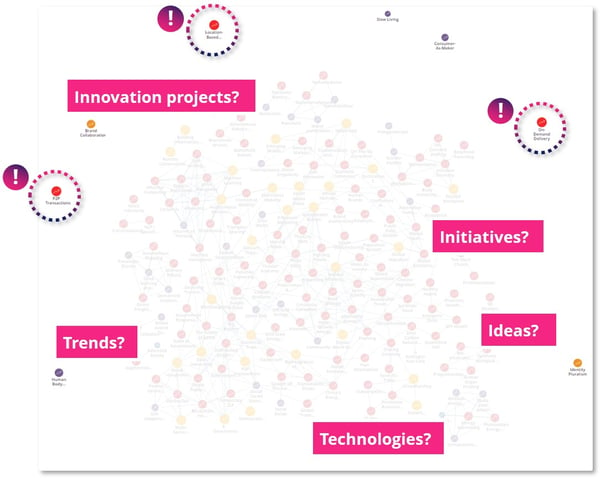
Are we actually doing the right thing? Are we actually working on the right projects?
The following questions can help you:
- How high do I estimate the disruption potential of a specific technology?
- How likely is it that this technology will change our daily work?
- What is the probability in the financial or insurance sector that this technology will improve business, services, and products?
AIs are currently not able to answer these questions; to do so we need people who are able to determine the relevance of a technology or idea.
If you have set priorities for each of these points, you can identify different aspects:
- Trends, technologies, and initiatives that could fundamentally change your company in the upcoming years
- Vulnerabilities such as trends or technologies that are not linked to any of your initiatives
- Trends that you classify as irrelevant, but which are linked to numerous initiatives and burn resources
We would like to deal with the future, but the day-to-day business simply overwhelms us.
In such a case, you can reschedule initiatives that are insignificant. Instead, deploy your employees on the initiatives that move your business forward, including those that have been neglected in the past. In this way, you use your resources effectively instead of wasting them.
Doing an initial analysis is overwhelming for many because of the seemingly endless and ever-changing data. That's why you should use AI-based tools that help you to collect and structure data. They show you problem areas and hotspots; you then prioritize them yourself. At this point, you should also decide how you want to proceed with the findings.
Step 3: Set up AI bots for continuous trend and tech scouting
In the last step, you use AI again to put together a “team” of robots to work for you. Sounds strange at first? Well, let's have a look at how this can be set up in just a few steps. The AI bots can take on various tasks, e.g. regularly researching for new information in your sector. You can automate data mining with your bot team, so that your innovation graph remains up-to-date.
The bots receive specifications, e.g: "Search everything on sustainability". As soon as they find something relevant, you receive a notification, e.g. as an e-mail or push notification to your smartphone.
The bots read documents from databases and the Internet and compile a heat map that helps you uncover current trends. You can discuss these trends regularly in meetings: This way, new developments will never remain undiscovered.
Things change daily, and yet I now have a clear tool at hand for my innovation work.
The AI bots facilitate daily work for you and your team members. The research effort is reduced and you can devote more energy and free resources to the really hot topics: identifying trends and driving innovation. More about achieving business impact through AI-based trend detection
In addition to the heat map, you can also use trend and technology radars for visualization purposes. Build your own cockpit that you can rely on daily for your innovation work.
Are you ready for the topics of tomorrow? Start using AI-supported tools and revolutionize your innovation management!
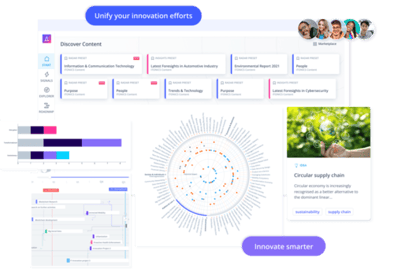
See the ITONICS Innovation OS in action


